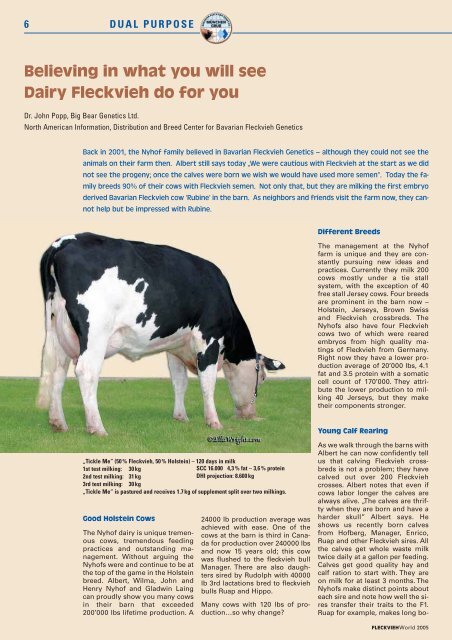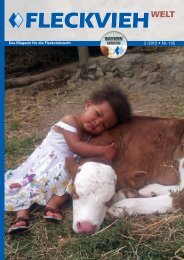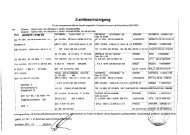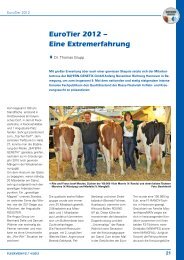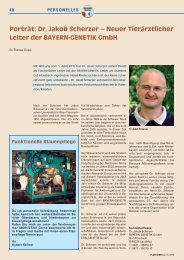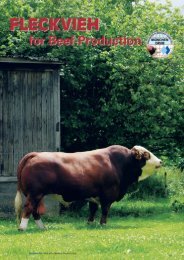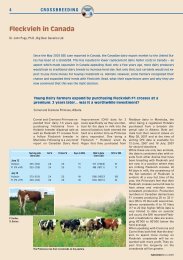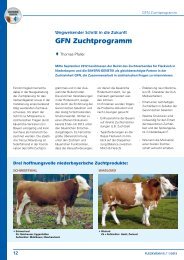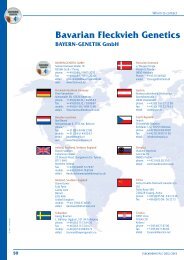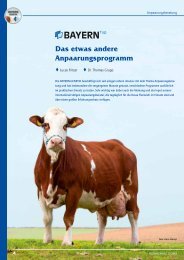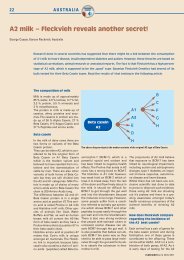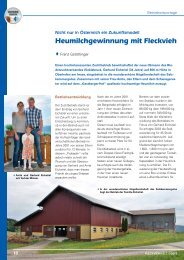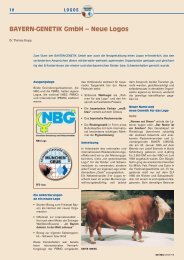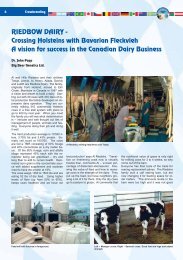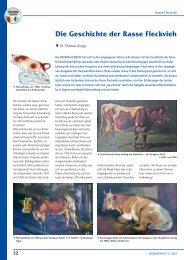Believing in what you will see Dairy Fleckvieh do for you
Believing in what you will see Dairy Fleckvieh do for you
Believing in what you will see Dairy Fleckvieh do for you
Create successful ePaper yourself
Turn your PDF publications into a flip-book with our unique Google optimized e-Paper software.
6 DUAL PURPOSE<br />
<strong>Believ<strong>in</strong>g</strong> <strong>in</strong> <strong>what</strong> <strong>you</strong> <strong>will</strong> <strong>see</strong><br />
<strong>Dairy</strong> <strong>Fleckvieh</strong> <strong>do</strong> <strong>for</strong> <strong>you</strong><br />
Dr. John Popp, Big Bear Genetics Ltd.<br />
North American In<strong>for</strong>mation, Distribution and Breed Center <strong>for</strong> Bavarian <strong>Fleckvieh</strong> Genetics<br />
Back <strong>in</strong> 2001, the Nyhof family believed <strong>in</strong> Bavarian <strong>Fleckvieh</strong> Genetics – although they could not <strong>see</strong> the<br />
animals on their farm then. Albert still says today „We were cautious with <strong>Fleckvieh</strong> at the start as we did<br />
not <strong>see</strong> the progeny; once the calves were born we wish we would have used more semen“. Today the family<br />
breeds 90% of their cows with <strong>Fleckvieh</strong> semen. Not only that, but they are milk<strong>in</strong>g the first embryo<br />
derived Bavarian <strong>Fleckvieh</strong> cow ‘Rub<strong>in</strong>e’ <strong>in</strong> the barn. As neighbors and friends visit the farm now, they cannot<br />
help but be impressed with Rub<strong>in</strong>e.<br />
„Tickle Me“ (50 % <strong>Fleckvieh</strong>, 50 % Holste<strong>in</strong>) – 120 days <strong>in</strong> milk<br />
1st test milk<strong>in</strong>g: 30 kg<br />
2nd test milk<strong>in</strong>g: 31 kg<br />
3rd test milk<strong>in</strong>g: 30 kg<br />
„Tickle Me“ is pastured and receives 1.7 kg of supplement split over two milk<strong>in</strong>gs.<br />
Good Holste<strong>in</strong> Cows<br />
The Nyhof dairy is unique tremenous<br />
cows, tremen<strong>do</strong>us feed<strong>in</strong>g<br />
practices and outstand<strong>in</strong>g management.<br />
Without argu<strong>in</strong>g the<br />
Nyhofs were and cont<strong>in</strong>ue to be at<br />
the top of the game <strong>in</strong> the Holste<strong>in</strong><br />
breed. Albert, Wilma, John and<br />
Henry Nyhof and Gladw<strong>in</strong> La<strong>in</strong>g<br />
can proudly show <strong>you</strong> many cows<br />
<strong>in</strong> their barn that exceeded<br />
200’000 lbs lifetime production. A<br />
SCC 16.000 4,3 % fat – 3,6 % prote<strong>in</strong><br />
DHI projection: 8.600 kg<br />
24000 lb production average was<br />
achieved with ease. One of the<br />
cows at the barn is third <strong>in</strong> Canada<br />
<strong>for</strong> production over 240000 lbs<br />
and now 15 years old; this cow<br />
was flushed to the fleckvieh bull<br />
Manager. There are also daughters<br />
sired by Ru<strong>do</strong>lph with 40000<br />
lb 3rd lactations bred to fleckvieh<br />
bulls Ruap and Hippo.<br />
Many cows with 120 lbs of production…so<br />
why change?<br />
Different Breeds<br />
The management at the Nyhof<br />
farm is unique and they are constantly<br />
pursu<strong>in</strong>g new ideas and<br />
practices. Currently they milk 200<br />
cows mostly under a tie stall<br />
system, with the exception of 40<br />
free stall Jersey cows. Four breeds<br />
are prom<strong>in</strong>ent <strong>in</strong> the barn now –<br />
Holste<strong>in</strong>, Jerseys, Brown Swiss<br />
and <strong>Fleckvieh</strong> crossbreds. The<br />
Nyhofs also have four <strong>Fleckvieh</strong><br />
cows two of which were reared<br />
embryos from high quality mat<strong>in</strong>gs<br />
of <strong>Fleckvieh</strong> from Germany.<br />
Right now they have a lower production<br />
average of 20’000 lbs, 4.1<br />
fat and 3.5 prote<strong>in</strong> with a somatic<br />
cell count of 170’000. They attribute<br />
the lower production to milk<strong>in</strong>g<br />
40 Jerseys, but they make<br />
their components stronger.<br />
Young Calf Rear<strong>in</strong>g<br />
As we walk through the barns with<br />
Albert he can now confidently tell<br />
us that calv<strong>in</strong>g <strong>Fleckvieh</strong> crossbreds<br />
is not a problem; they have<br />
calved out over 200 <strong>Fleckvieh</strong><br />
crosses. Albert notes that even if<br />
cows labor longer the calves are<br />
always alive. „The calves are thrifty<br />
when they are born and have a<br />
harder skull” Albert says. He<br />
shows us recently born calves<br />
from Hofberg, Manager, Enrico,<br />
Ruap and other <strong>Fleckvieh</strong> sires. All<br />
the calves get whole waste milk<br />
twice daily at a gallon per feed<strong>in</strong>g.<br />
Calves get good quality hay and<br />
calf ration to start with. They are<br />
on milk <strong>for</strong> at least 3 months. The<br />
Nyhofs make dist<strong>in</strong>ct po<strong>in</strong>ts about<br />
each sire and note how well the sires<br />
transfer their traits to the F1.<br />
Ruap <strong>for</strong> example, makes long bo-<br />
FLECKVIEHWorld 2005
Tremen<strong>do</strong>us quality alfalfa hay<br />
Relative feed value 187 – Crude prote<strong>in</strong> 22%<br />
died calves with excellent feet and<br />
legs. Enrico is easy calv<strong>in</strong>g; he<br />
puts a little more muscle on calves<br />
and his offspr<strong>in</strong>g are outstand<strong>in</strong>g<br />
<strong>for</strong> type. It’s been another cold<br />
w<strong>in</strong>ter <strong>in</strong> January with overnight<br />
temperatures below -30 Celsius<br />
<strong>for</strong> almost one month straight;<br />
John Nyhof and Gladw<strong>in</strong> La<strong>in</strong>g<br />
both note – „the calves are healthy<br />
and they want to live; if they <strong>do</strong><br />
get sick, they recover where we<br />
would often th<strong>in</strong>k to give up”. Calf<br />
survival is also better with <strong>Fleckvieh</strong><br />
crossbreds. John comments<br />
that „of ten calves born n<strong>in</strong>e <strong>will</strong><br />
be alive a year later if they are<br />
<strong>Fleckvieh</strong> cross”.<br />
The Feed<strong>in</strong>g Program<br />
Roughage is the key <strong>in</strong>gredient <strong>in</strong><br />
the feed<strong>in</strong>g program. The Nyhofs<br />
feed 62.5% silage and hay (alfalfa),<br />
2.5% straw, 35% gra<strong>in</strong> (12% prote<strong>in</strong><br />
- half corn; half barley with the<br />
supplement <strong>in</strong>cluded).<br />
They are proud of the quality feed<br />
they produce as John br<strong>in</strong>gs us a<br />
hay sample that tested 187 relative<br />
feed value. This is a high <strong>for</strong>age<br />
diet designed by the Nyhofs and<br />
their nutritionist to produce 65 to<br />
70 lbs of milk at 4.1% fat and 3.5%<br />
prote<strong>in</strong>. The cows are placed on<br />
this ration throughout their lactation.<br />
Feed turnover is outstand<strong>in</strong>g<br />
and <strong>in</strong>take is maximized without a<br />
<strong>do</strong>ubt – 66 lbs of dry feed <strong>in</strong>take<br />
per day – over 4% of the cows’ bodyweight<br />
daily. Def<strong>in</strong>itely someth<strong>in</strong>g<br />
to impress anyone that’s<br />
dabbled <strong>in</strong> rum<strong>in</strong>ant nutrition.<br />
The cows are full, they are healthy,<br />
they have excellent rumen function<br />
and reward the Nyhofs with milk.<br />
The cow tie stalls are equipped<br />
FLECKVIEHWorld 2005<br />
Right and left – 4 <strong>Fleckvieh</strong> cross calves<br />
Center top – 2 Holste<strong>in</strong> calves<br />
with com<strong>for</strong>t mats and bedded<br />
with f<strong>in</strong>ely chopped straw. The milk<br />
production on every cow is recorded<br />
daily by milk recorder.<br />
All data are submitted to <strong>Dairy</strong><br />
Herd Improvement (DHI). The Nyhofs<br />
now milk twice daily at 3:30<br />
<strong>in</strong> the morn<strong>in</strong>g and 3:30 <strong>in</strong> the afternoon.<br />
The first pure <strong>Fleckvieh</strong> and<br />
crossbred F1<br />
milk<strong>in</strong>g at the Farm<br />
On the day of our visit, Rub<strong>in</strong>e, a<br />
pure <strong>Fleckvieh</strong> 1st calf heifer was<br />
26 days <strong>in</strong>to lactation. She has<br />
been produc<strong>in</strong>g 80 to 85 lbs of<br />
milk. The Nyhofs have s<strong>in</strong>ce submitted<br />
milk <strong>for</strong> her components; at<br />
that time they were 4.2% fat and<br />
3.2% prote<strong>in</strong>, with a somatic cell<br />
3 Cow <strong>in</strong> Canada. 15 years old > 240000 lbs lifetime production<br />
DUAL PURPOSE 7<br />
count of 30’000. Eighty days later,<br />
Rub<strong>in</strong>e is still milk<strong>in</strong>g at the same<br />
level and has been bred to the bull<br />
Waterberg. <strong>Fleckvieh</strong> dairy cows<br />
have a flat lactation curve and we<br />
expect Rub<strong>in</strong>e to ma<strong>in</strong>ta<strong>in</strong> a<br />
strong production level late <strong>in</strong>to<br />
her lactation. Not peak<strong>in</strong>g as aggressively<br />
on the front end of the<br />
lactation is <strong>what</strong> makes <strong>Fleckvieh</strong><br />
easier to manage dur<strong>in</strong>g transition,<br />
but also throughout the lactation<br />
as they <strong>do</strong> not lose as much<br />
body condition, while ma<strong>in</strong>ta<strong>in</strong><strong>in</strong>g<br />
good production levels. When the<br />
race is over after 305 days of milk<strong>in</strong>g<br />
the <strong>Fleckvieh</strong> cows won’t f<strong>in</strong>ish<br />
last on total production, they<br />
just distribute it differently.<br />
At the time of writ<strong>in</strong>g, the first F1<br />
cross is now 19 days <strong>in</strong>to milk<strong>in</strong>g.<br />
A Manager cross daughter „Tickle<br />
Me“ out of a Holste<strong>in</strong> cow Lord Lil
8 DUAL PURPOSE<br />
Udder from „Rub<strong>in</strong>e“<br />
ly. She is now milk<strong>in</strong>g at 36 to 38<br />
liters and Albert is confident <strong>in</strong><br />
<strong>see</strong><strong>in</strong>g more from this heifer. He<br />
once aga<strong>in</strong> expresses his confidence<br />
„Now we have the milk–<br />
we are a fully confident that we<br />
made the right decision. This is a<br />
beautiful strong animal with a<br />
milk<strong>in</strong>g speed of 4.5 liters/m<strong>in</strong>ute!”.<br />
Mov<strong>in</strong>g more toward grass<br />
based dairy<strong>in</strong>g –<br />
reduc<strong>in</strong>g production costs<br />
One system serves two purposes –<br />
a stanchion type milk<strong>in</strong>g parlor is<br />
used <strong>in</strong> the w<strong>in</strong>ter <strong>for</strong> the 40 free<br />
stall cows where they are fed 17.5<br />
lbs of supplementary feed split<br />
over two milk<strong>in</strong>gs. In the summer<br />
this system is used more extensively<br />
<strong>for</strong> the pastured dairy cattle. The<br />
Nyhofs milk 140 pastured cows<br />
along with 60 <strong>in</strong> the tie barn.<br />
The cows on pasture receive 4 lbs<br />
of supplement split over the two<br />
milk<strong>in</strong>gs. Albert admits their pa-<br />
stured dairy production is reduced<br />
to 55 to 60 lbs/day, however the<br />
cost to produce milk is substantially<br />
lower. „Overall, our production<br />
balances with the w<strong>in</strong>ter months”<br />
Albert says „<strong>Fleckvieh</strong> cattle are<br />
aggressive graziers and their sound<br />
feet and legs should go a long way<br />
<strong>for</strong> them to go out and harvest the<br />
feed <strong>for</strong> us – <strong>in</strong>stead of us runn<strong>in</strong>g<br />
beh<strong>in</strong>d them”.<br />
The Nyhofs have their pastures<br />
<strong>see</strong>ded to perennial ryegrass, a diploid<br />
creep<strong>in</strong>g rooted variety that<br />
they obta<strong>in</strong>ed from Oregon. This<br />
grass is extremely tolerant to graz<strong>in</strong>g<br />
as they manage their cows to<br />
be graz<strong>in</strong>g the <strong>for</strong>age at 4 to 9 <strong>in</strong>ches<br />
<strong>in</strong> height. The pastures are<br />
split fertilized with 40 lbs of nitrogen<br />
on the first cycle, followed by<br />
two further cycles of 30 lbs of nitrogen.<br />
John and Henry note that<br />
this keeps pastures vigorous and<br />
healthy and the nutrition <strong>for</strong> the<br />
cows at optimum. The ryegrass also<br />
easily re<strong>see</strong>ds itself.<br />
Happy about <strong>Fleckvieh</strong>!<br />
Pictured left to right: - John and Albert Nyhof, Nyhof Farms<br />
- Werner Popp – President, Big Bear Genetics Ltd.<br />
John Nyhof and Rub<strong>in</strong>e – nice temperament and good teat placement<br />
Fertility and health<br />
Is the <strong>in</strong>vestment <strong>in</strong> <strong>Fleckvieh</strong> semen<br />
worthwhile? The Nyhof family<br />
and others that have used <strong>Fleckvieh</strong><br />
po<strong>in</strong>t to its better fertility. S<strong>in</strong>ce<br />
us<strong>in</strong>g <strong>Fleckvieh</strong>, the Nyhofs tell<br />
us that they are requir<strong>in</strong>g 1.8 services/conception<br />
<strong>do</strong>wn from 2.6 services<br />
which they were previously<br />
used to. As a result they also expect<br />
to reduce their <strong>in</strong>tercalv<strong>in</strong>g<br />
period <strong>do</strong>wn from 14 months. Many<br />
of the dairies <strong>in</strong> Germany are<br />
runn<strong>in</strong>g <strong>in</strong>tercalv<strong>in</strong>g periods of 12<br />
to 12.5 months – another goal to<br />
pursue. These animals are def<strong>in</strong>itely<br />
healthier, the Nyhofs note – veter<strong>in</strong>ary<br />
costs are dropp<strong>in</strong>g. For<br />
further <strong>in</strong><strong>for</strong>mation on <strong>Dairy</strong> <strong>Fleckvieh</strong><br />
or to contact the Nyhofs directly<br />
please contact: John or Werner<br />
Popp; Big Bear Genetics Ltd.,<br />
North American In<strong>for</strong>mation, Distribution<br />
and Breed Center <strong>for</strong><br />
Bavarian <strong>Fleckvieh</strong> Genetics, Erikkson,<br />
Manitoba CA (204) 636-2387<br />
or 2665; bigbeargenetics@mts.net<br />
www.fleckvieh.de<br />
Rub<strong>in</strong>e – 26 days lactation 85 lbs<br />
4.2 % Fat, 3.2 % Prote<strong>in</strong>, Good <strong>for</strong>eudder<br />
DHI projection 21365 lbs at 305 days<br />
FLECKVIEHWorld 2005


